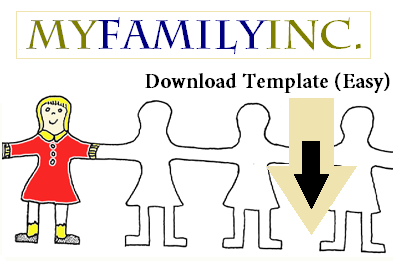Your personal finance, either alone or together with your family, should be thought of as a business. You have income and expenses, and therefore you have an income statement. Likewise, you have assets (capital values of what you own or take title to), and liabilities (debts that you owe). Your assets and liabilities make up your family balance sheet for your business.
To get into the right frame of inspiration, give your family business a name. That’s right. If you cannot think of one, consider calling yourself “My Family Retirement Business, Inc.” or another name of your choosing.

Just like all businesses, your family retirement business has financial statements. In another blog post we talked about tracking your expenses and income (your budget). This post will help you with perhaps the most important financial tracking consideration – tracking your personal liabilities and assets, and determining your family net worth.
Your balance sheet is a snapshot in time that is composed of the total of your assets and liabilities. When liabilities are subtracted from your assets, this becomes your net worth. Your net worth is your “financial bottom line.”
I am going to help you determine your assets and liabilities. The first thing you need to do is print out my sample Family Balance Sheet (Assets and Liabilities) Template. You can modify this to meet your personal needs.
Calculating your Family Assets
As you can see on your printed Family Balance Sheet (Assets and Liabilities) Template, there are sections under the Family Assets section for Personal Assets, Short Term Investments, Pension and Retirement Accounts, Vehicles, Real Estate, and Business.
Each one of these line items represents an asset that you own. You can use this sheet as your permanent record, or if appropriate, for in preparation for a meeting with myself as financial planner. Next to each line item, you should track your account numbers and the source of your asset. The completed balance sheet can also be included in your personal files, along with your will and other estate planning documents.
Current Assets in accounting practice are ordered by way of liquidity. At the top are assets that can be liquidated, or sold, relatively quickly. This would include bank accounts and high yield investment accounts. Further down the list are assets that are intended for longer term holdings, such as your home or other real estate. These type of assets cannot be liquidated quickly.
Asset values can be recorded as market value (as you would sell it for today) or by book value (the amount you paid for the asset). Your asset values will not include any debt that you owe because of owning that asset.
After you have filled in all the Assets that you own, total up the Assets and put on the total line.
Calculating your Family Liabilities
Family liabilities are debts that you own, often secured against an asset. It is important to remember that Family Assets are listed with a value not including the debt, and liabilities are listed without including any details on what the initial loan value was. The liability value you wish to include on your worksheet is the amount that you owe today.
As with your Family Assets, your Family Liabilities have sub sections, and are listed in order of the time line expected to pay off the debts. Short Term liabilities are shorter duration and term than Long Term liabilities such as mortgages which may be over a 20-25 year period or more. A vehicle loan as an example, might be for a period of four (4) years.
Credit card debt is a short-term liability but I have included a separate line for credit cards since they are not considered a good lending device. You should not have credit card debt that you do not pay off in full each month, due to relative high-interest rates compared to short term loans. There may be other options, and paying off credit card debt is an absolute priority.
Attached to each line item, you should track your account numbers and the source of your liability. This information is important to keep in your estate planning files.
After you have completed the list of your liabilities, you can total up the amounts you own and place the total on the worksheet.
Your Family Net Worth “Financial Bottom Line”
After you have the totals for Family Assets and Family Liabilities, you wish to subtract the two numbers. Family Assets less Family Liabilities = Your Family Net Worth. This is the amount you and your family are “worth.” Contact me for an initial evaluation of what these numbers mean in terms of your long-term goals. I can help you understand what it means.
Start now.
Yes, start now.
Download Family Balance Sheet (Assets and Liabilities) Template (Easy)
by Joanne David CFP FCSI

Download Family Balance Sheet (Assets and Liabilities) Template
Or if you prefer, try one of my recommended mobile budget applications to help you track your assets (owned) and liabilities (debts owed). The important part is to get going today!
Ask for a review
Ask me for a review. I would love to help you understand your assets and liabilities. Organizing your affairs is the first step of any long-term financial plan. Please message using our contact form.
![]() Book Your No Obligation Financial and Portfolio Review
Book Your No Obligation Financial and Portfolio Review![]()











 Joanne David BA CFP FCSI
Joanne David BA CFP FCSI




 Joanne David CFP FCSI
Joanne David CFP FCSI


